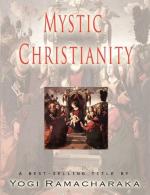In this declaration, the belief in the Divinity of Jesus is made. The Apostles’ Creed shows the cruder conception, rather inclining toward the perverted idea of the conception of the Virgin by the aid of the Holy Ghost, similar to the origin of the hero-gods of the different religions in which the father was one of the gods and the mother a woman. But the Nicene creed gives at least a strong hint of the mystic teachings. It speaks of Him as “begotten of his Father”—“begotten, not made.” The expressions, “God of God; Light of Light; very God of very God,” show the idea of identical spiritual substance in the Spirit. And then the remarkable expression, “being of one substance with the Father,” shows a wonderful understanding of the Mystery of The Christ. For, as the mystic teachings show, Jesus was a pure Spirit, free from the entangling desires and clogging Karma of the world. Identical in substance with the Father. “The Father and I are one,” as He said. Is there anything in the Orthodox Theology that throws such light on this subject as is shed by Mystic Christianity’s teaching regarding the nature of the soul of Jesus?
“Born of the Virgin Mary.”—(Apostles’ Creed.)
“Who for us men and for our salvation came down from heaven, and was incarnate by the Holy Ghost of the Virgin Mary, and was made man.”—(Nicene Creed.)
The Nicene Creed here gives a surprisingly clear statement of the Mystic teachings. “Who for us men and our salvation came down from heaven” shows the purpose of the incarnation. “Came down from heaven” shows pre-existence in the bosom of the Absolute. “And was incarnate” shows the descent of the Spirit into the flesh in the womb of Mary. “And was made man” shows the taking on of the physical body of the infant in the womb. Does not the Mystic teaching give a clearer light on this statement of the Creed?
“Was crucified, dead and buried; he descended into hell; the third day he rose again from the dead.”—(Apostles’ Creed.)
“He suffered and was buried, and the third day he rose again according to the scriptures, and sitteth on the right hand of the Father.”—(Nicene Creed.)
The “descent into hell” of the Apostles’ Creed of course meant the passing to the place of disembodied souls—the lower Astral Plane. Even the orthodox teachers do not now pretend that the term “hell” meant the place of torture presided over by the Devil, which theology has invented to frighten people into the churches. “The third day he arose from the dead” (and the corresponding passage in the Nicene Creed) refers to the appearance in the Astral Body—the return from the Astral Plane in which He had sojourned for the three days following the crucifixion. “And ascended into heaven”—this passage shows the belief that He returned to the place from which He came, for the Nicene Creed has stated that he “came down from heaven and was incarnate ... and was made man.”




